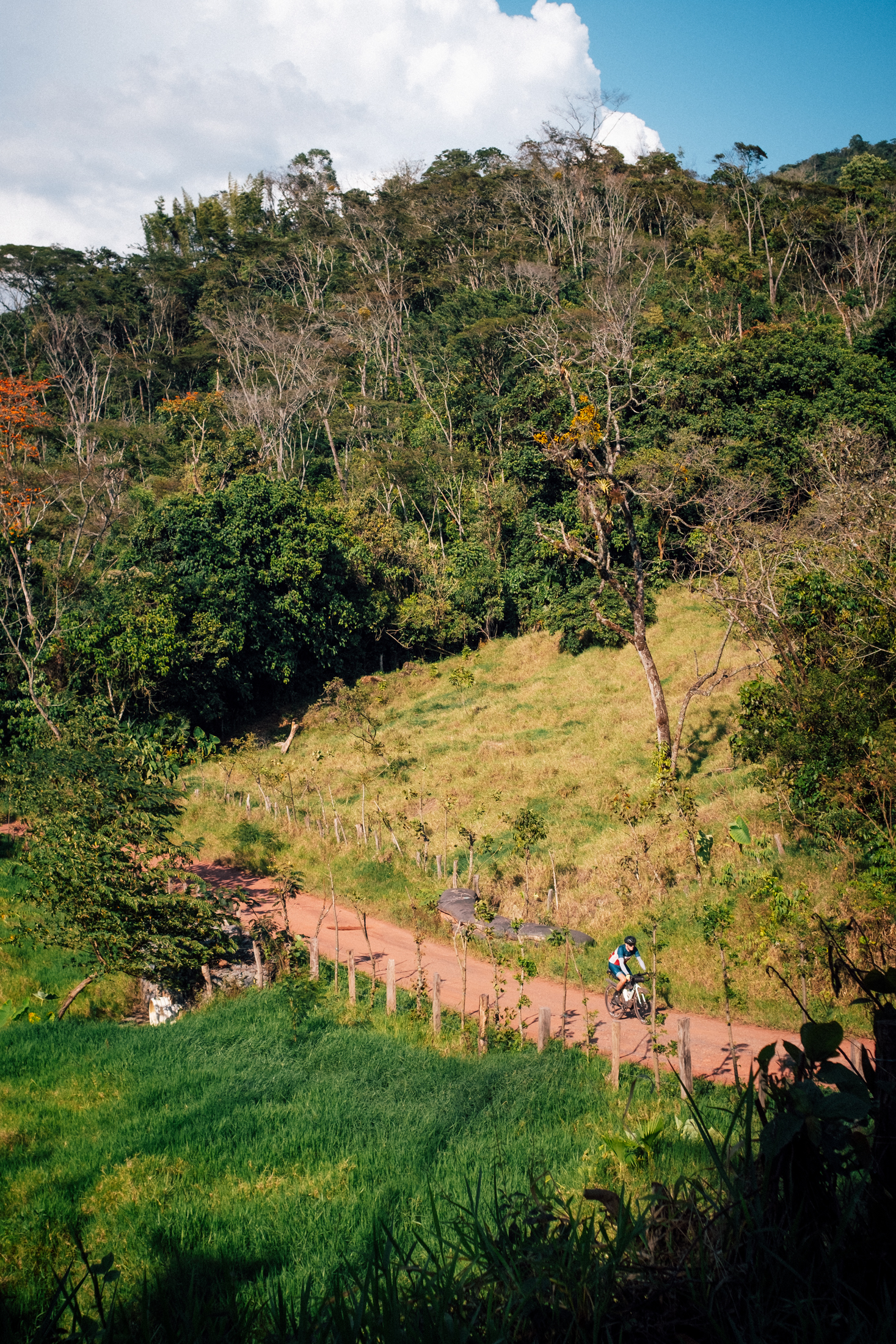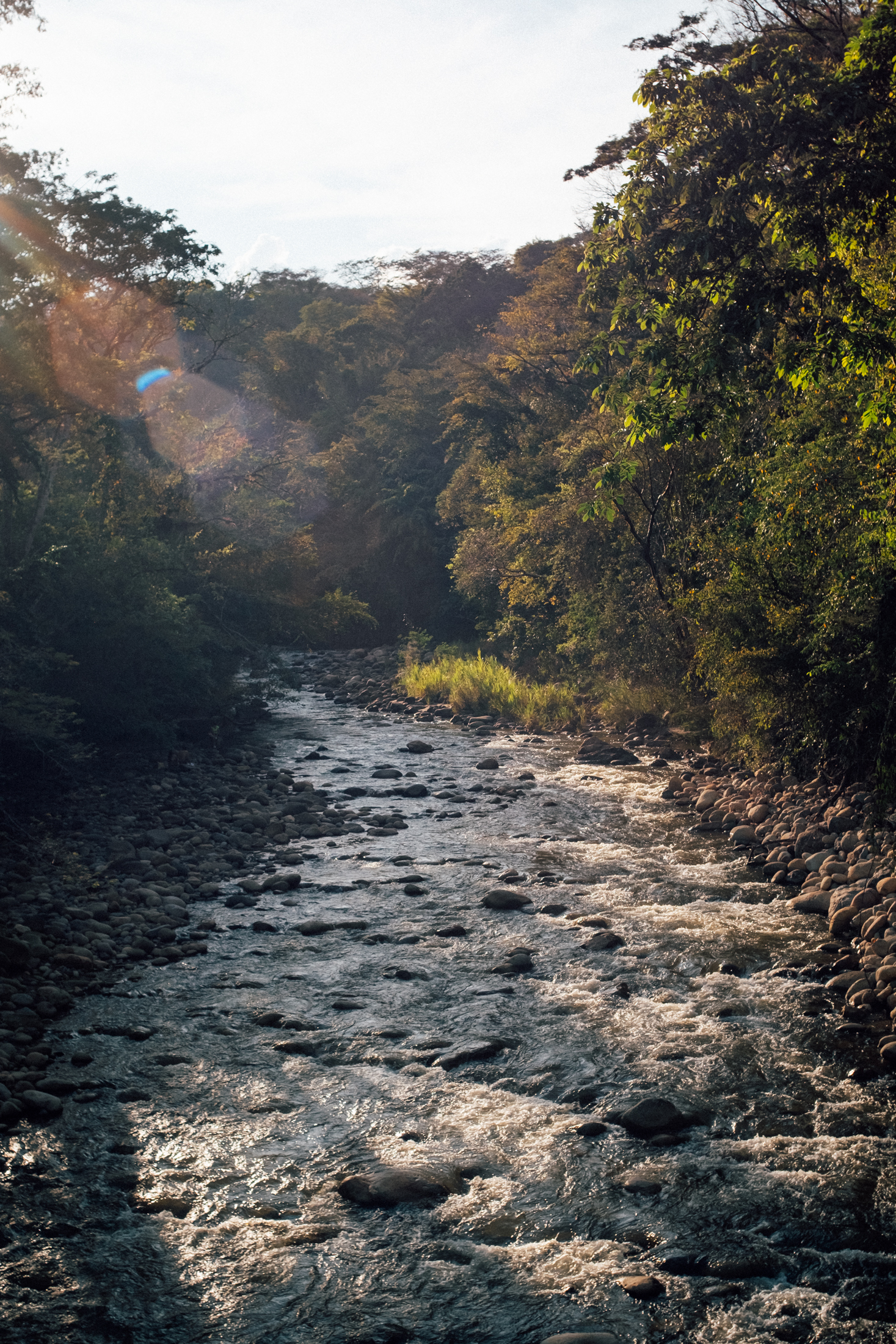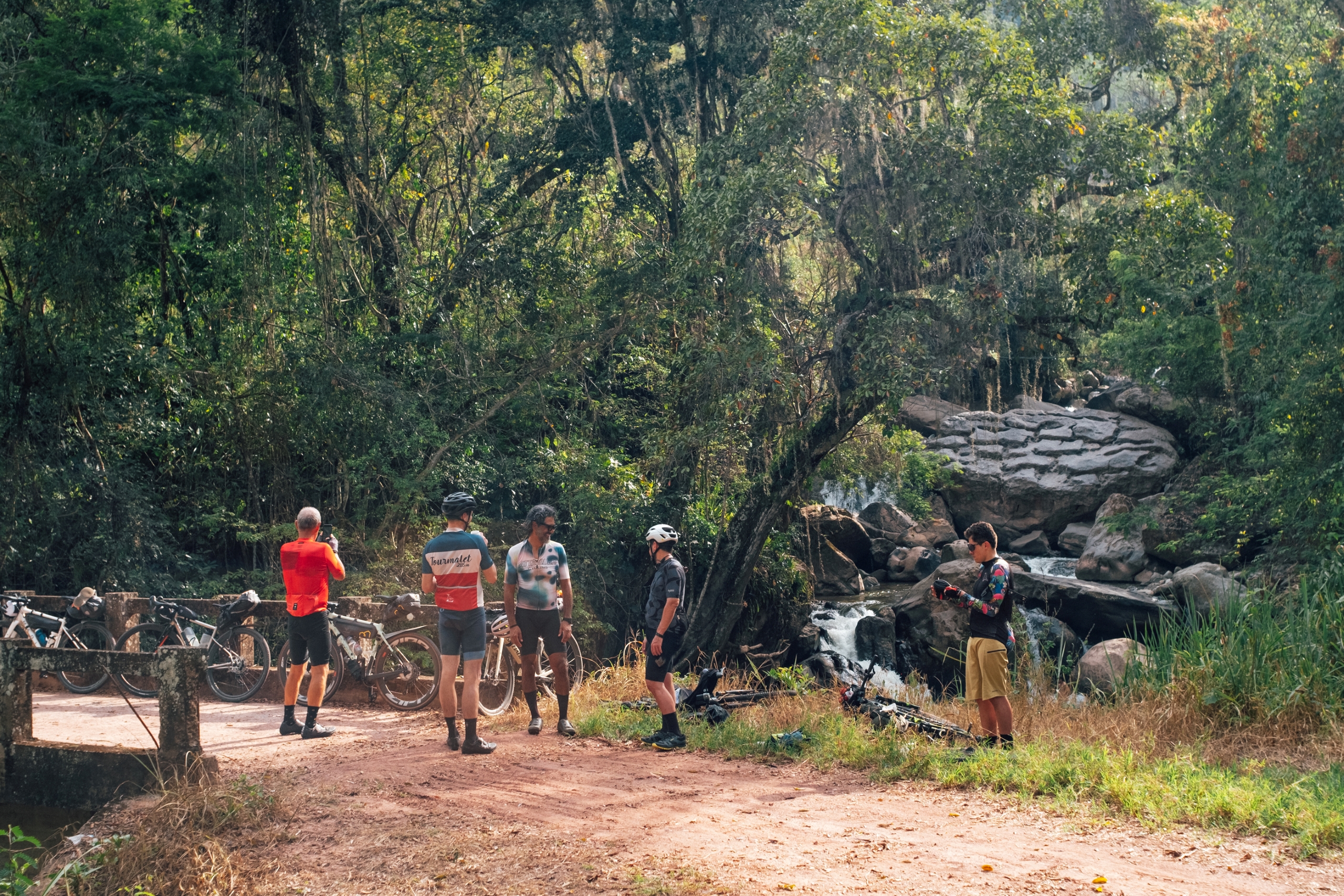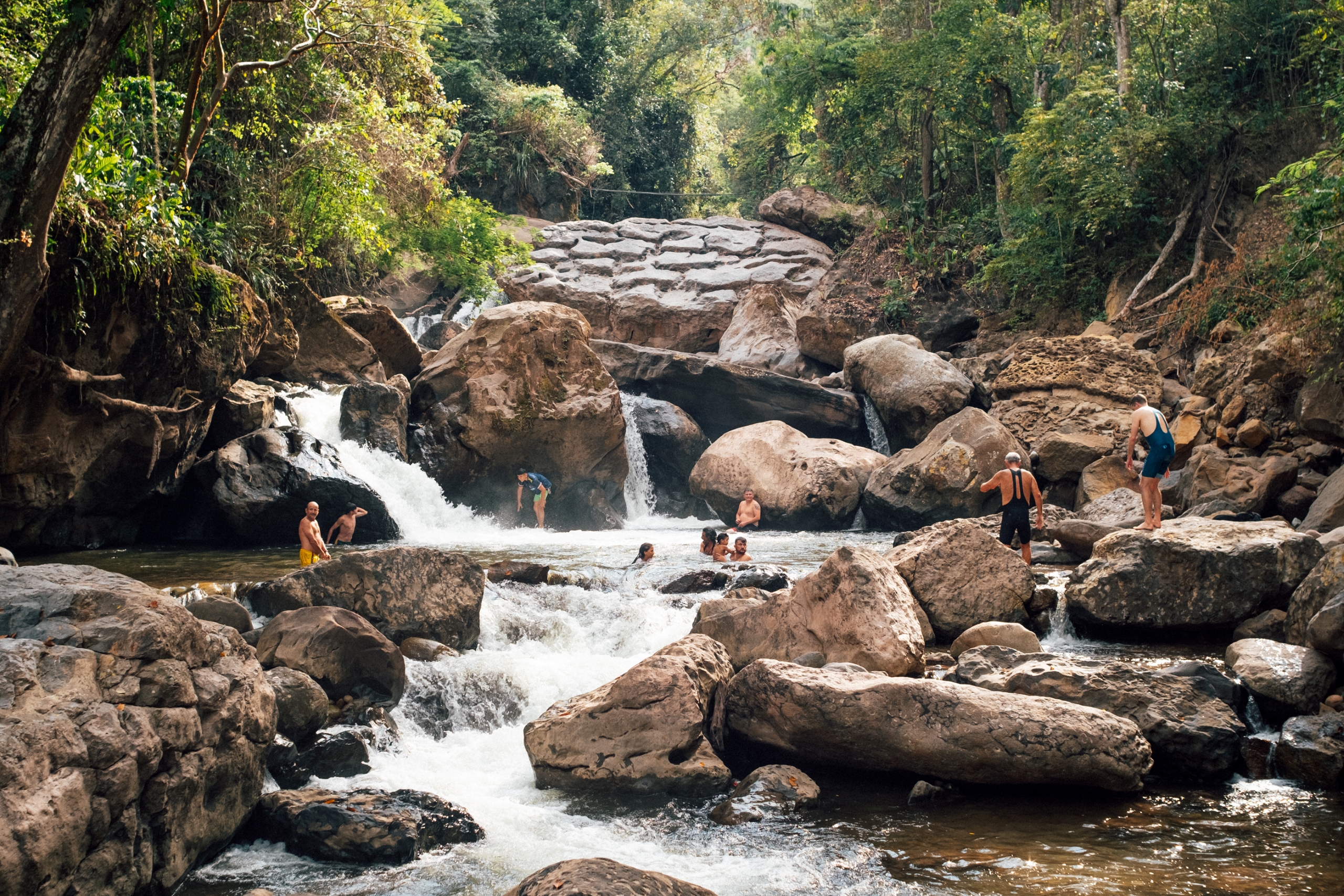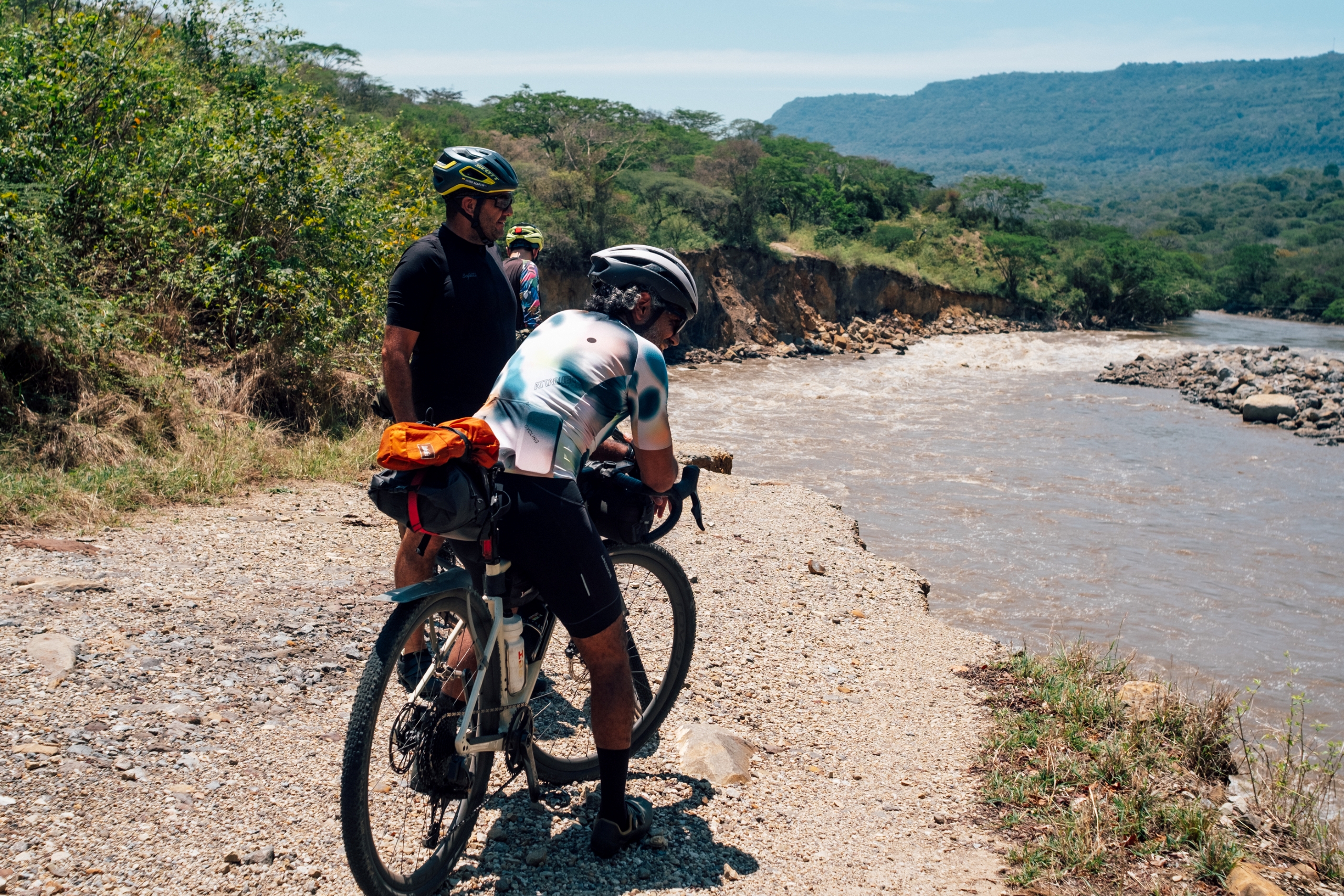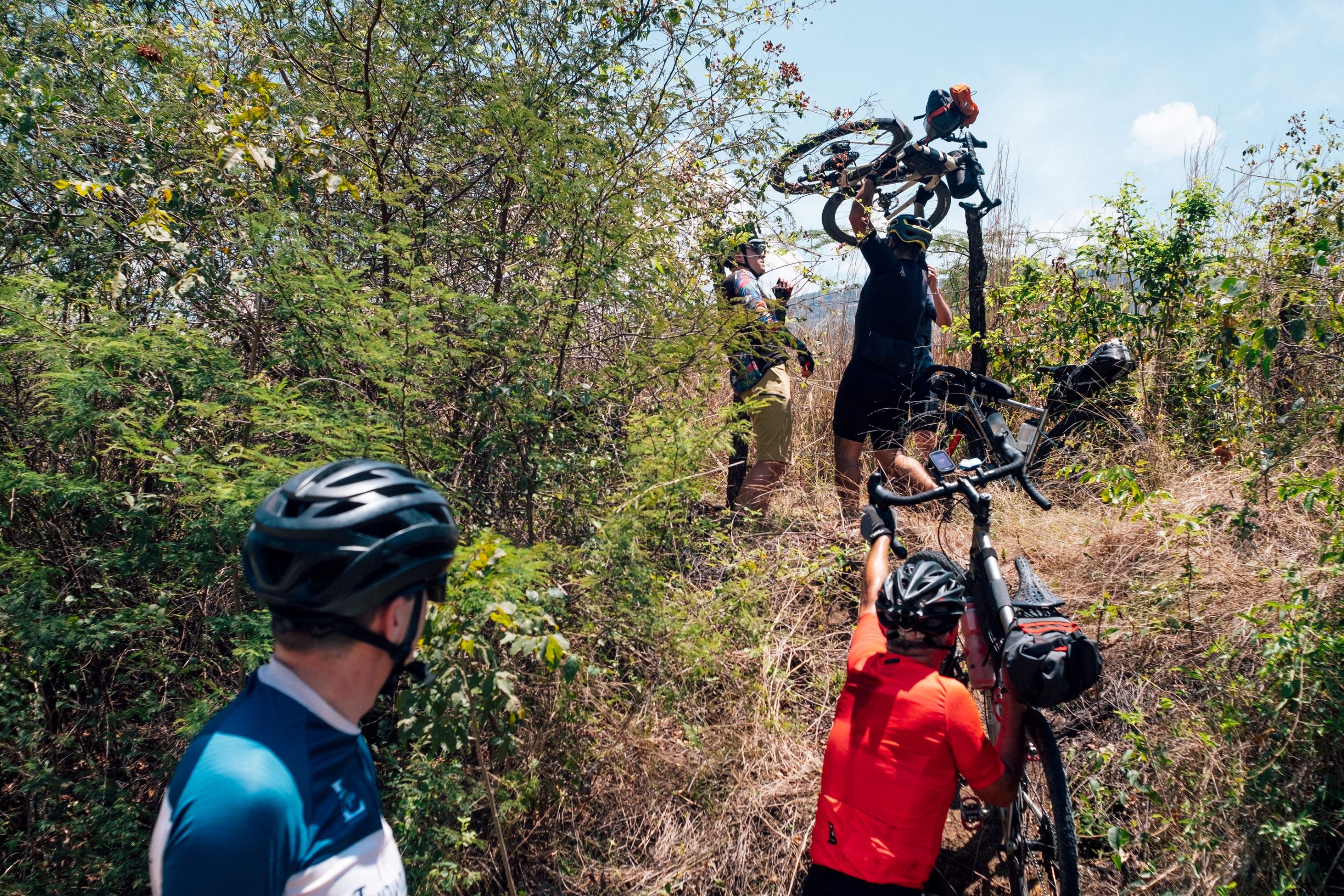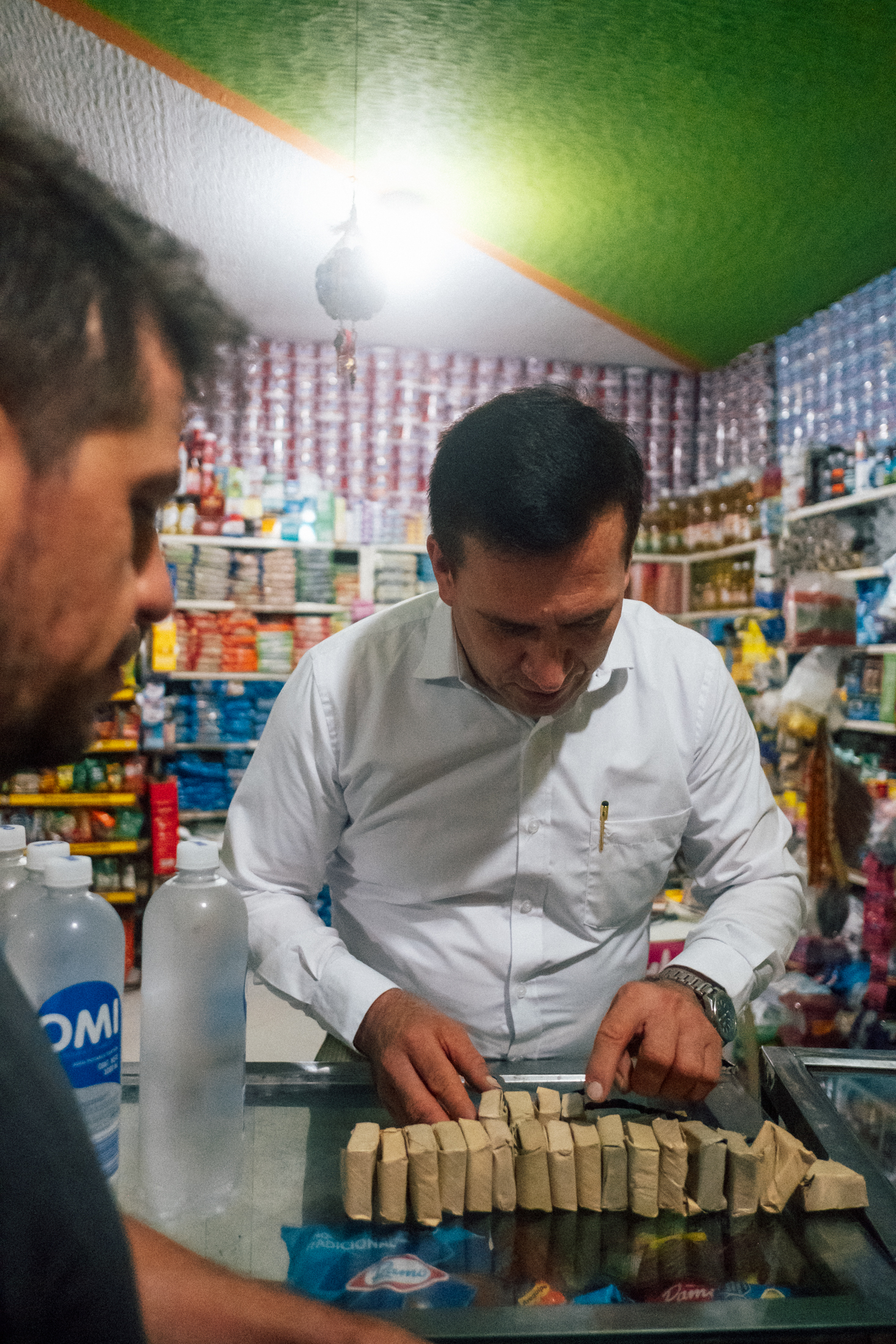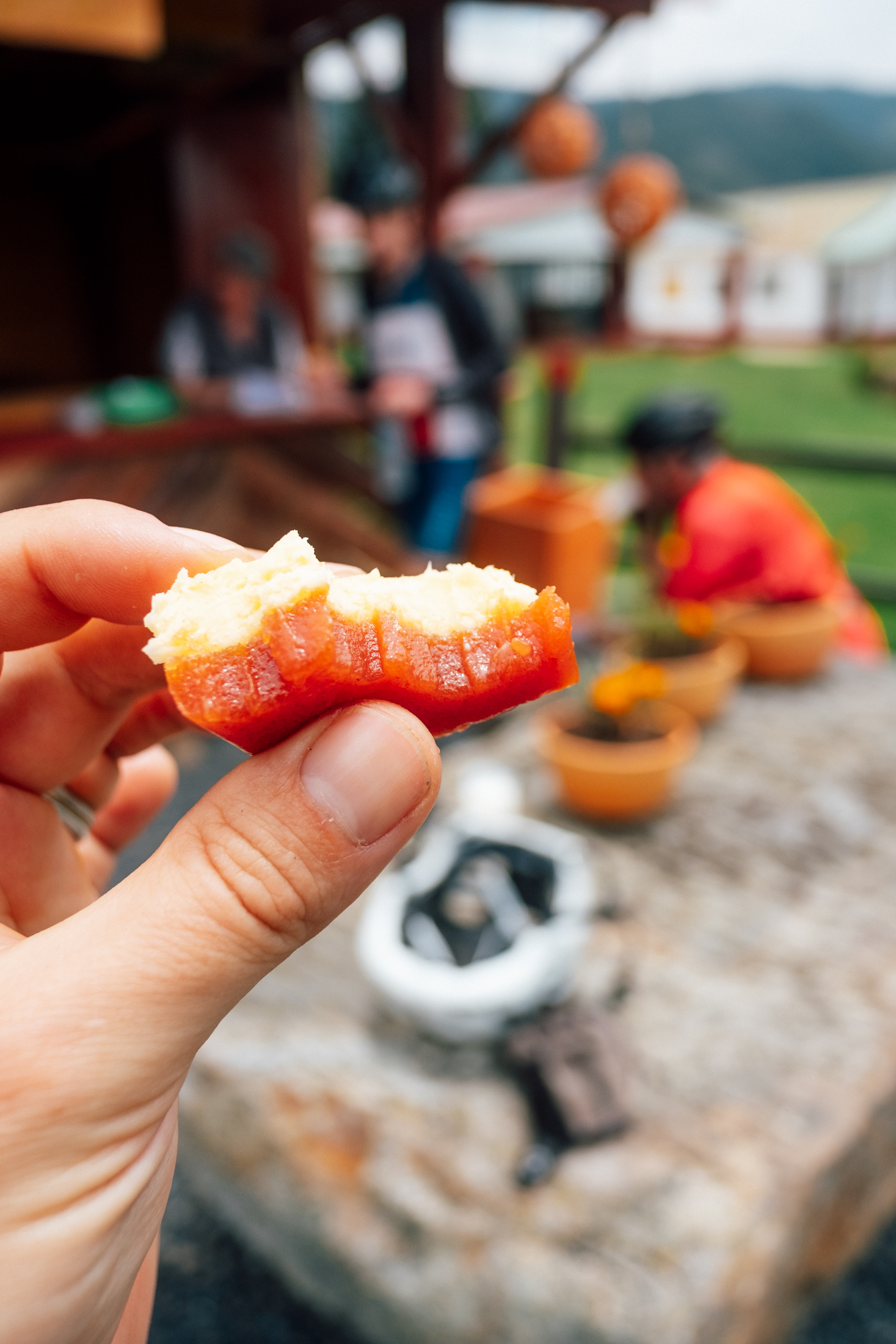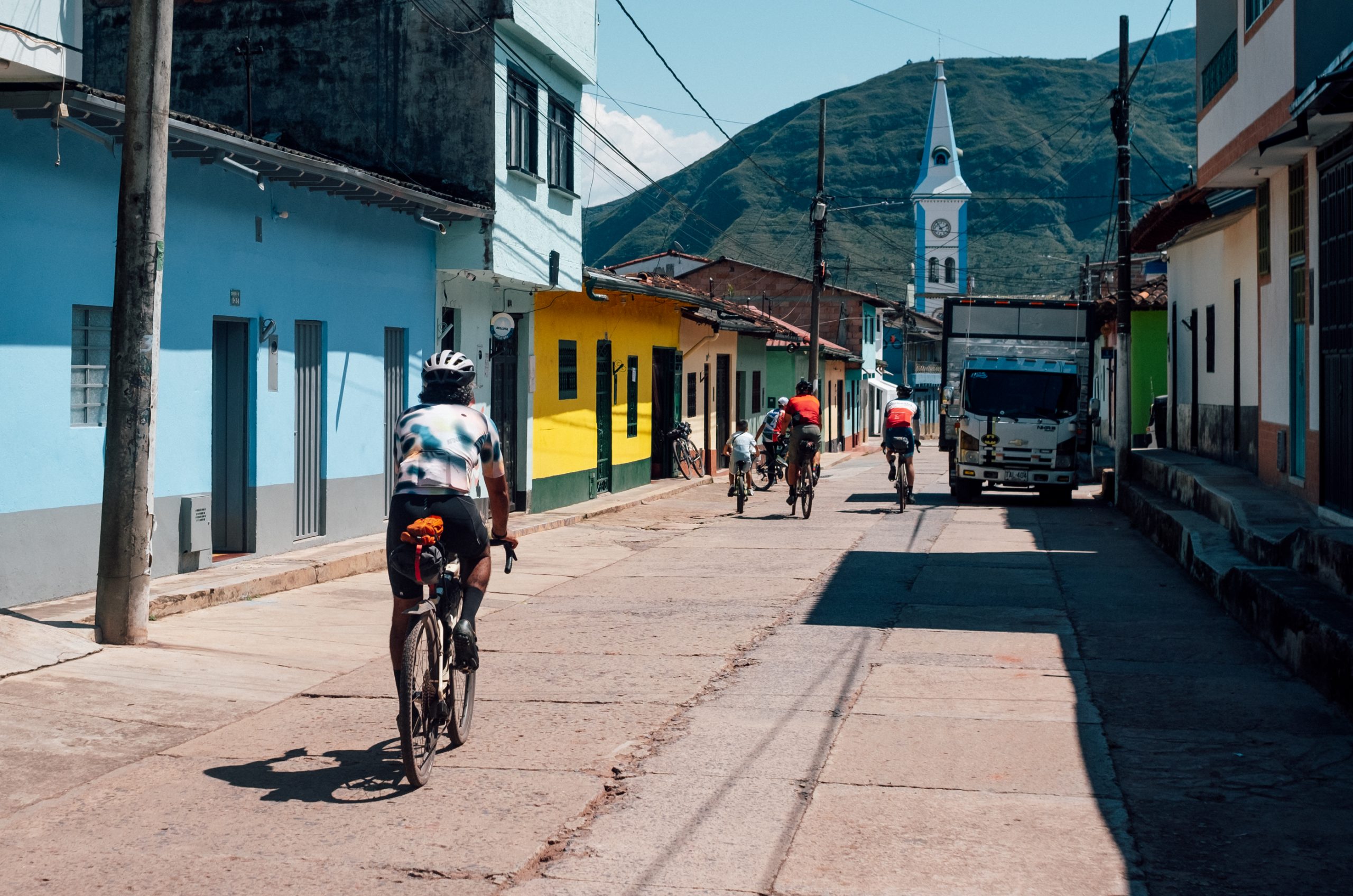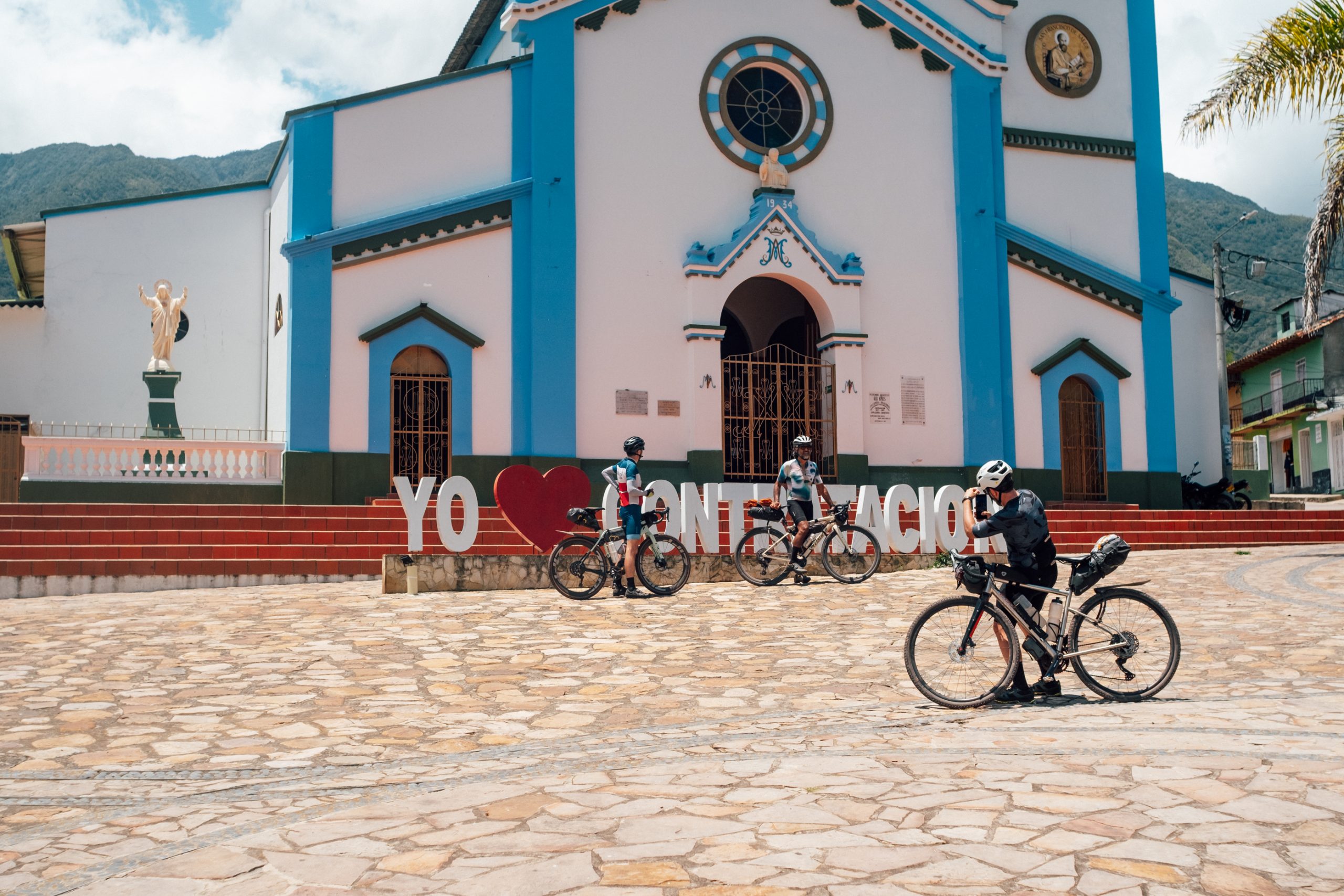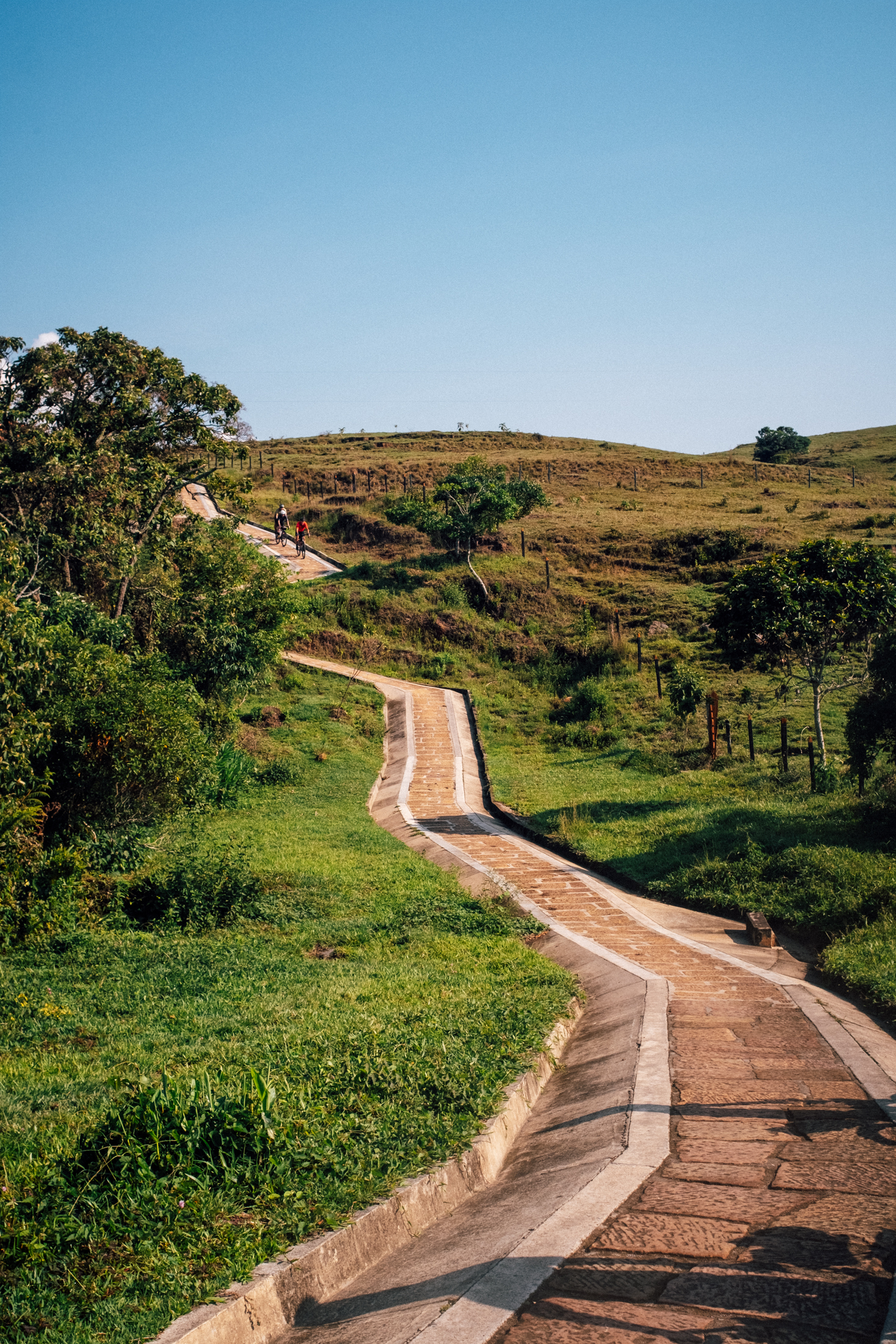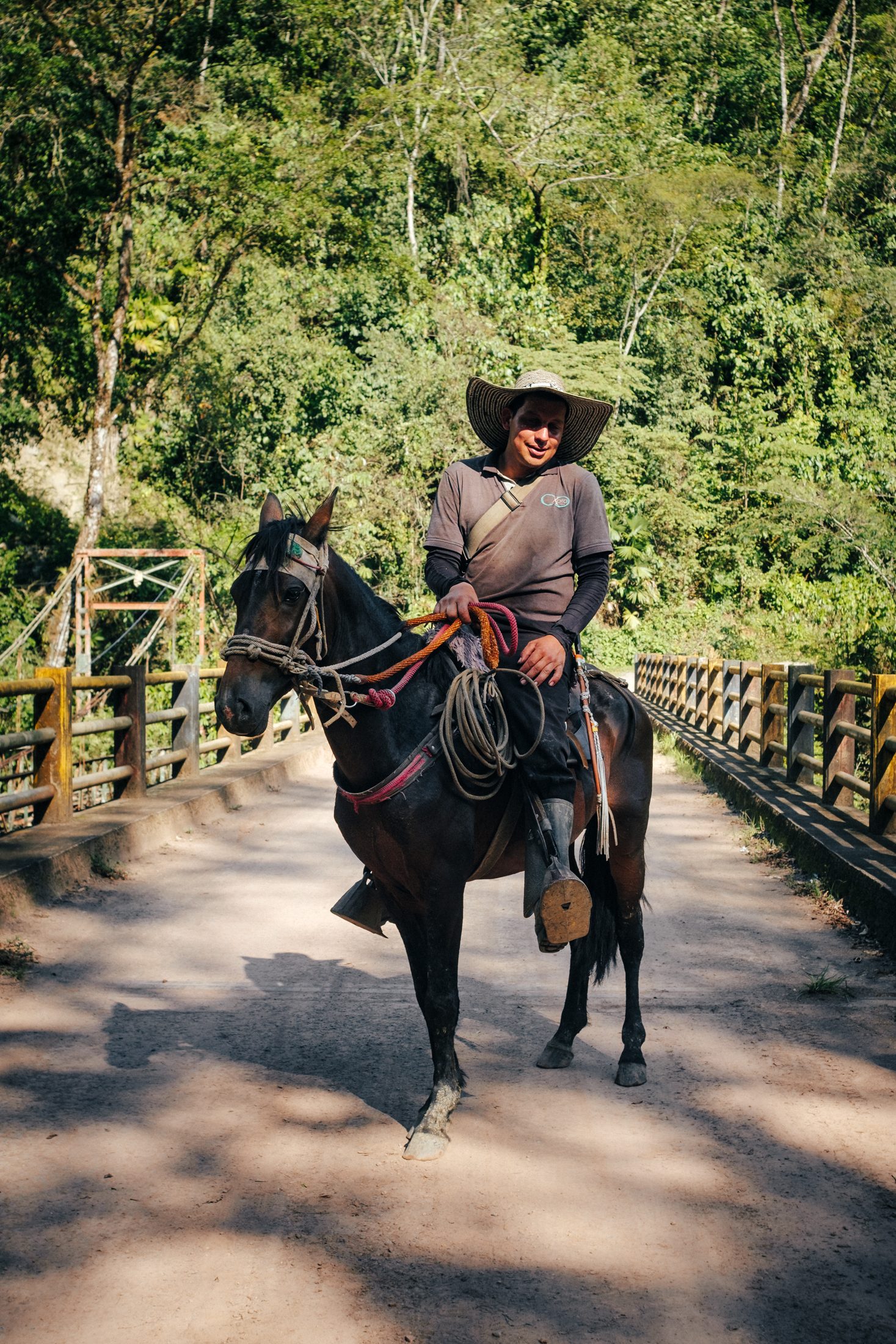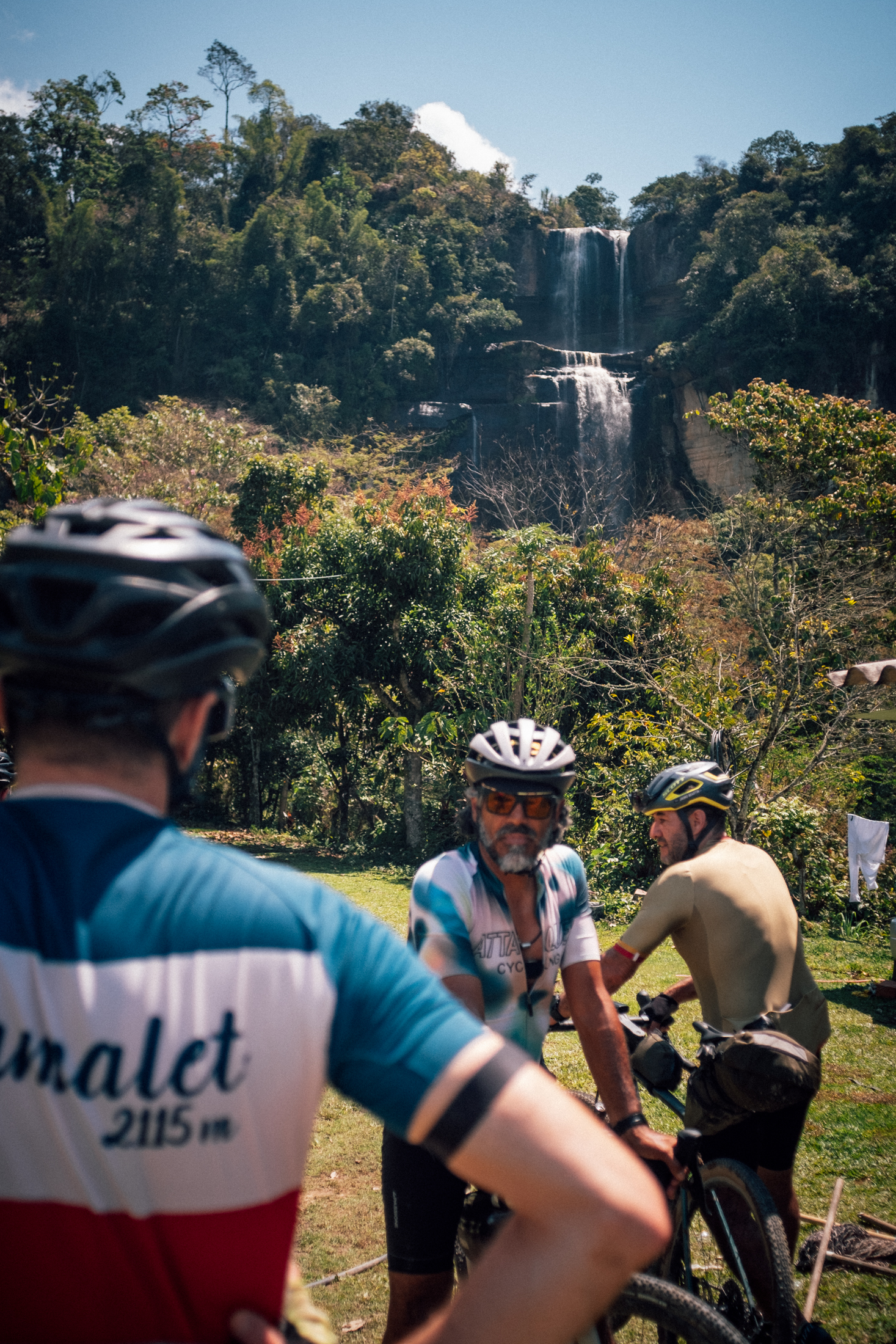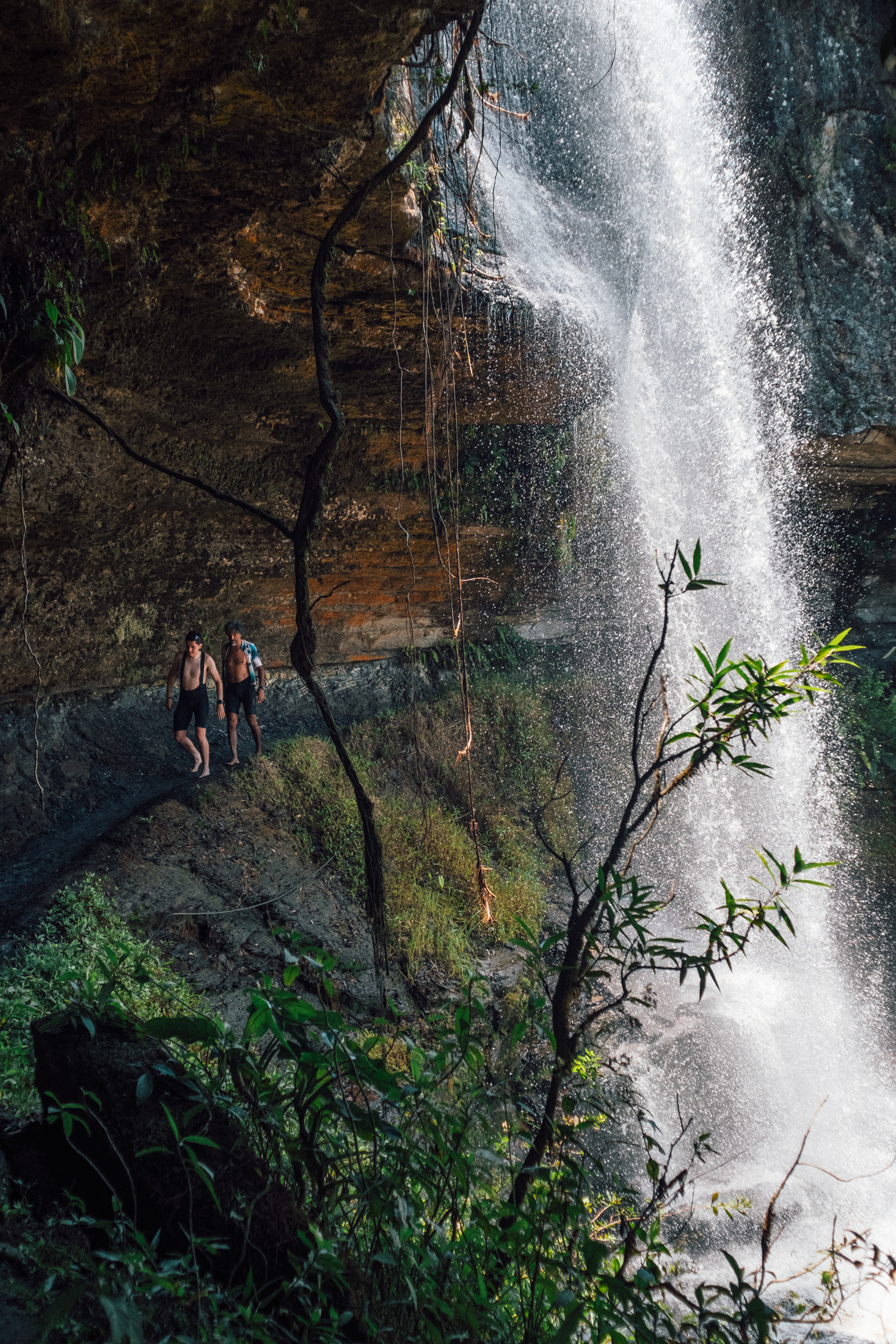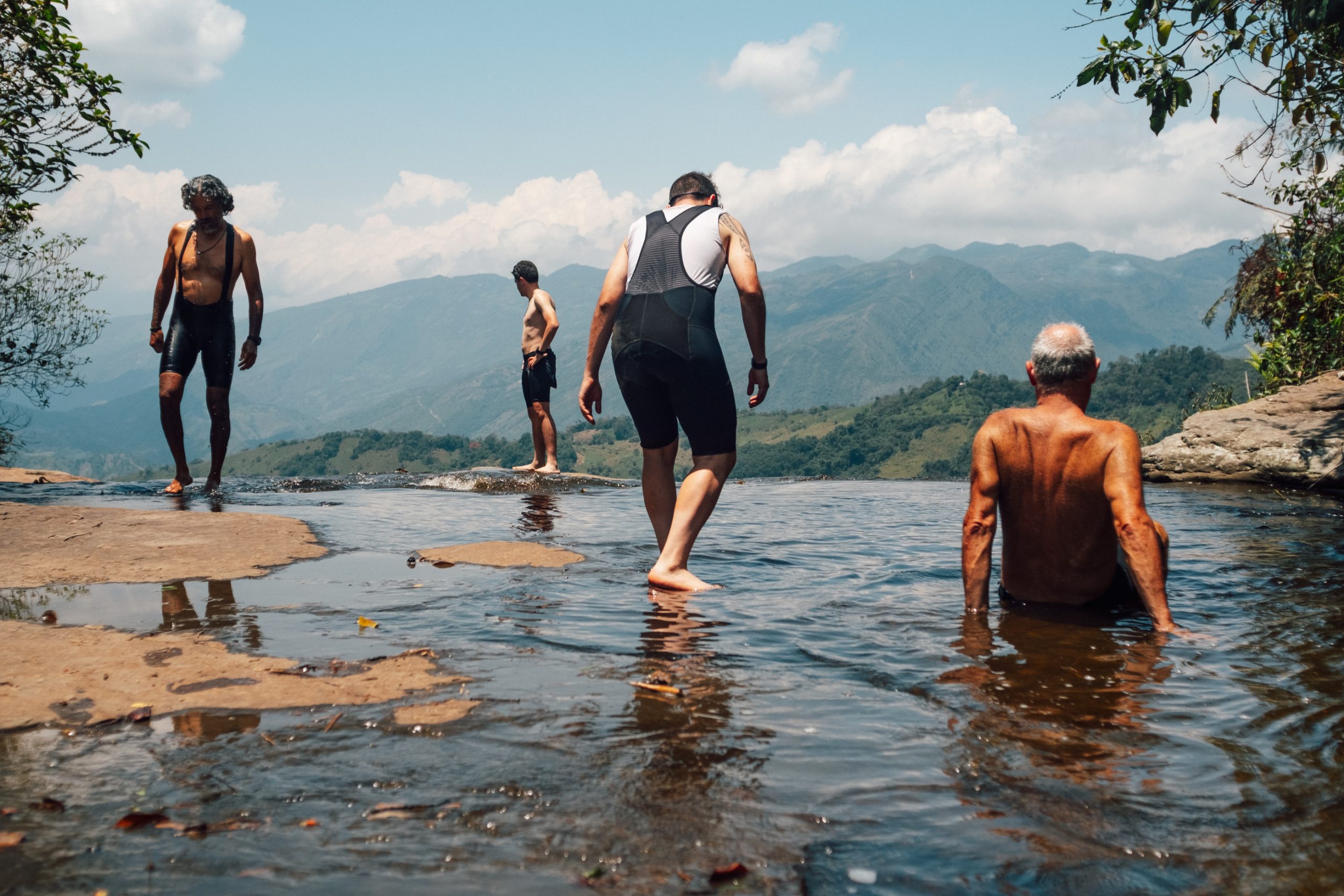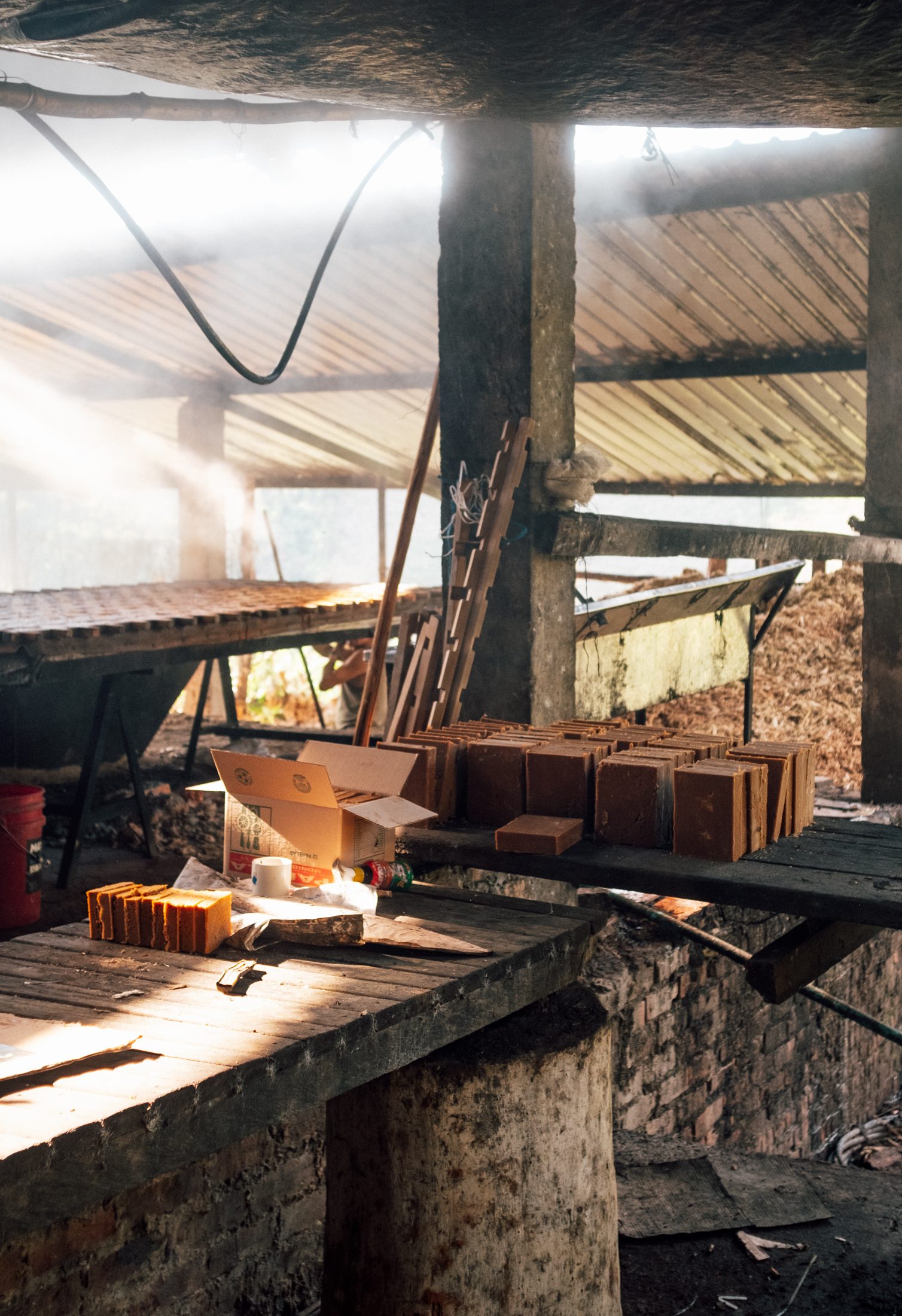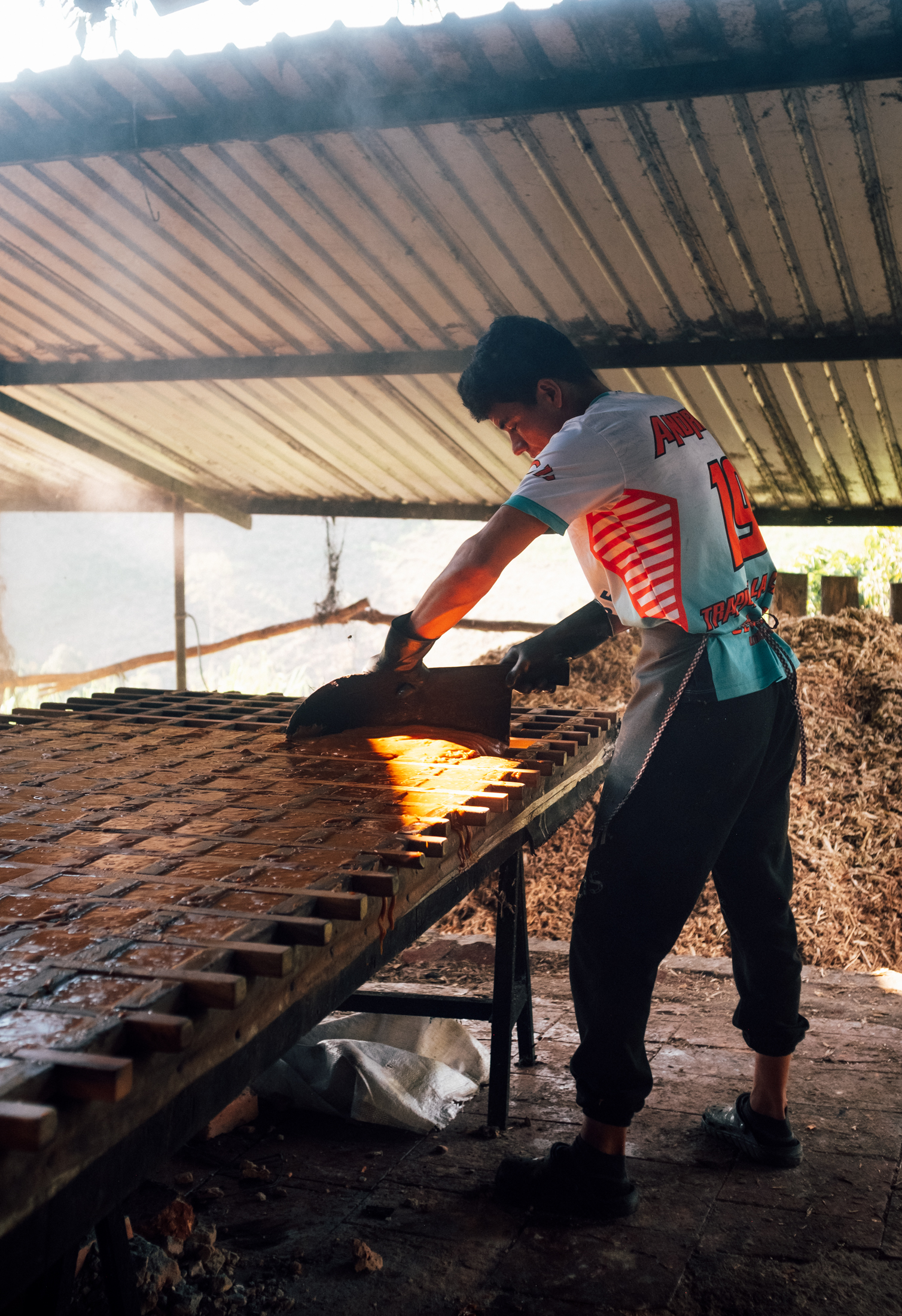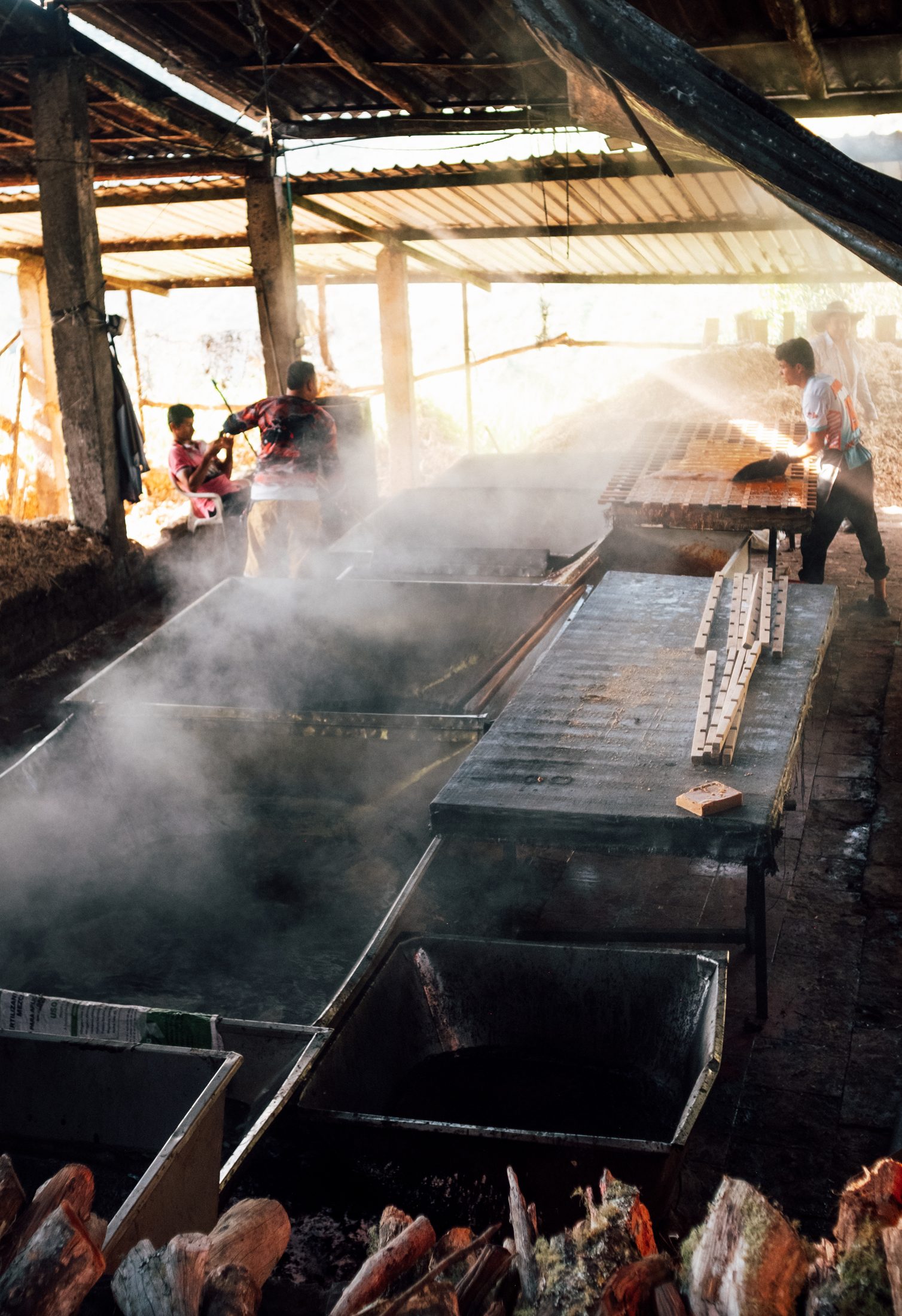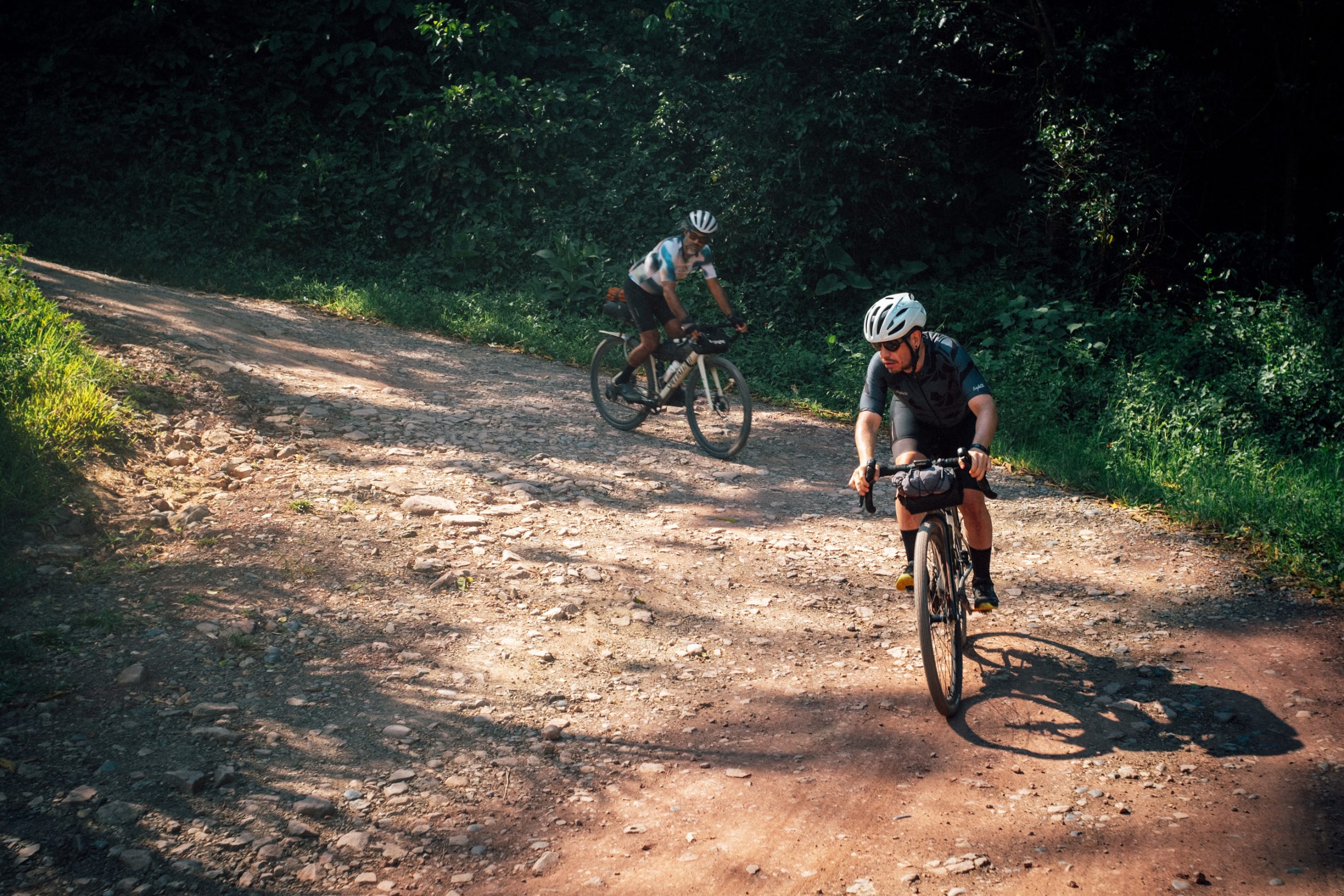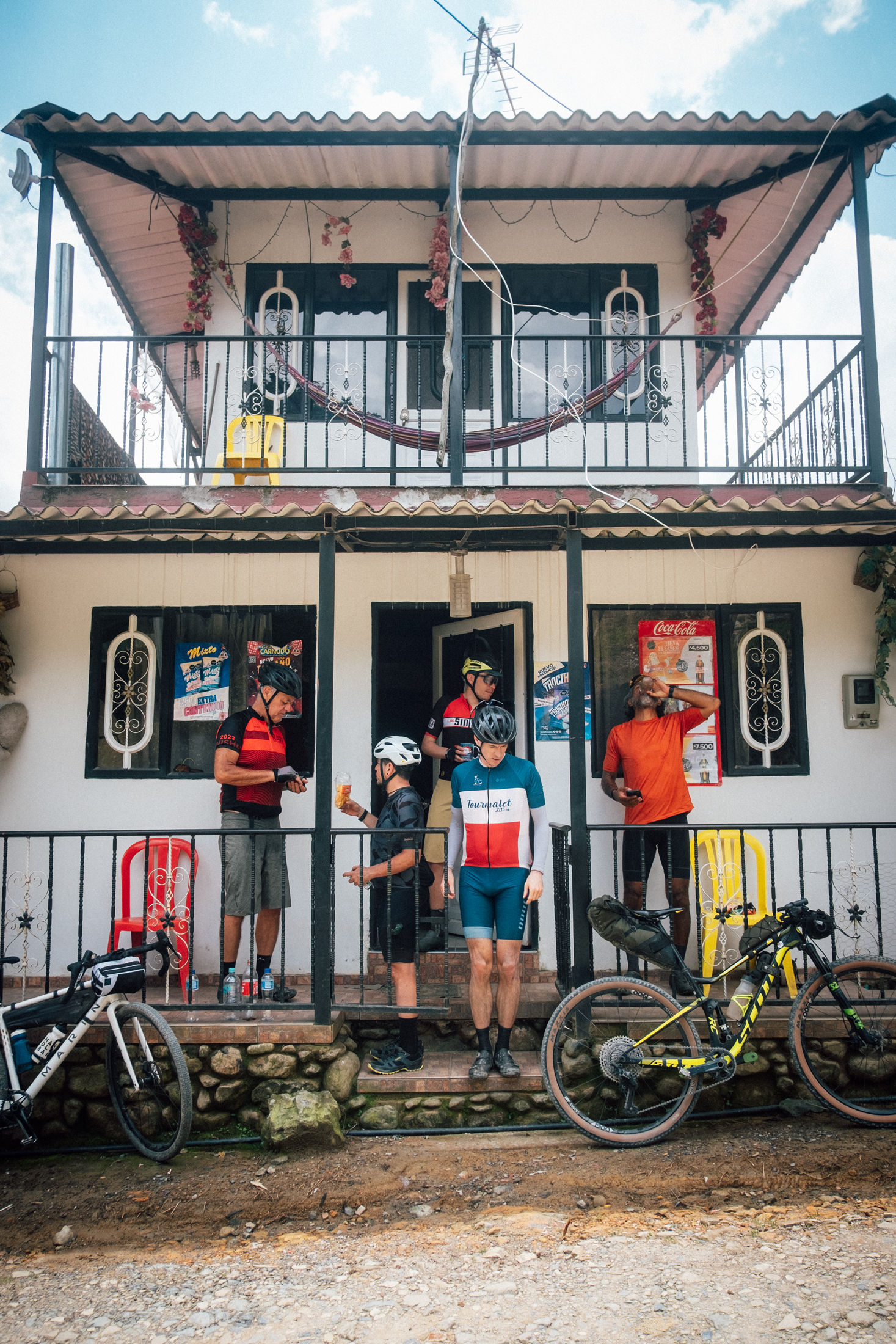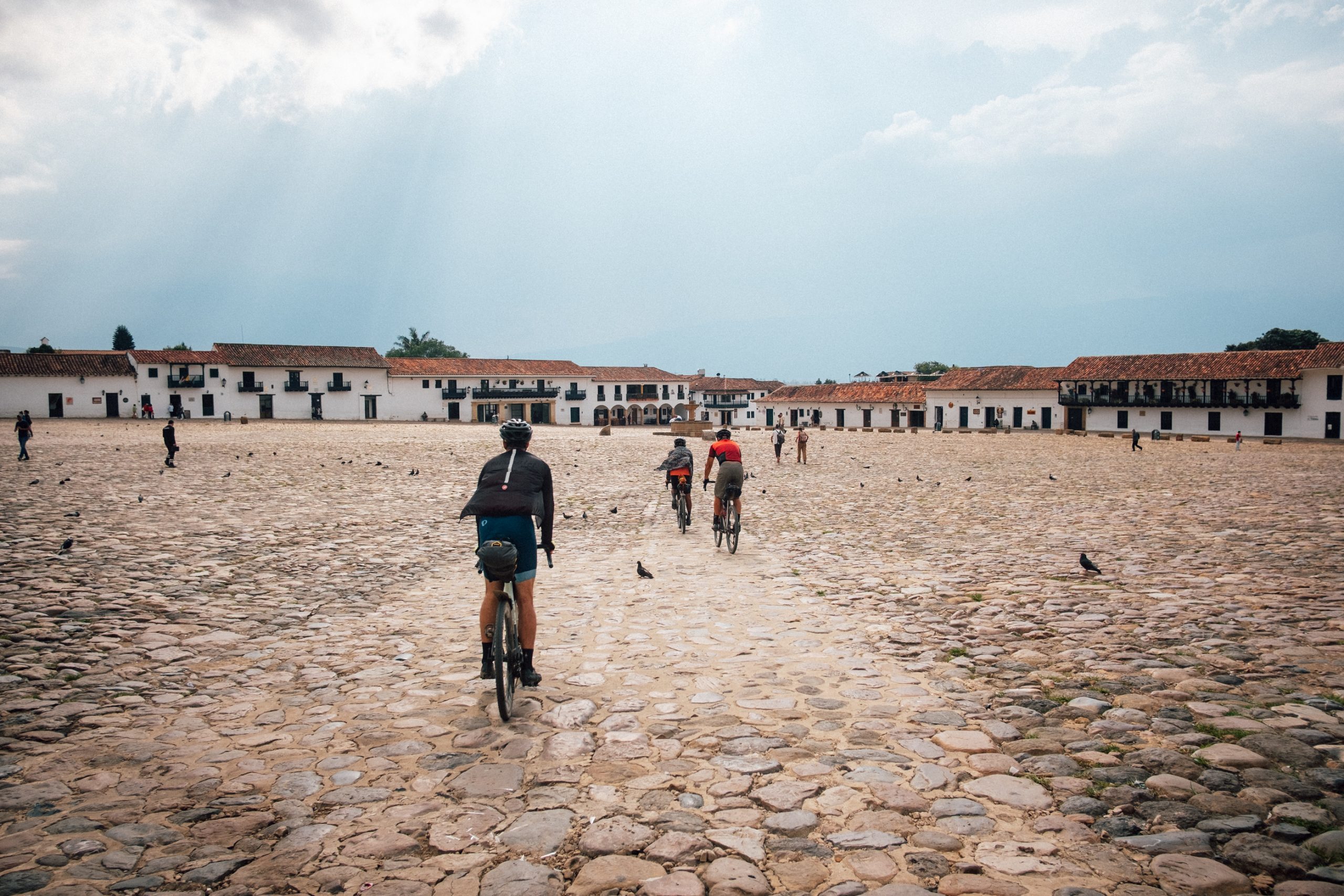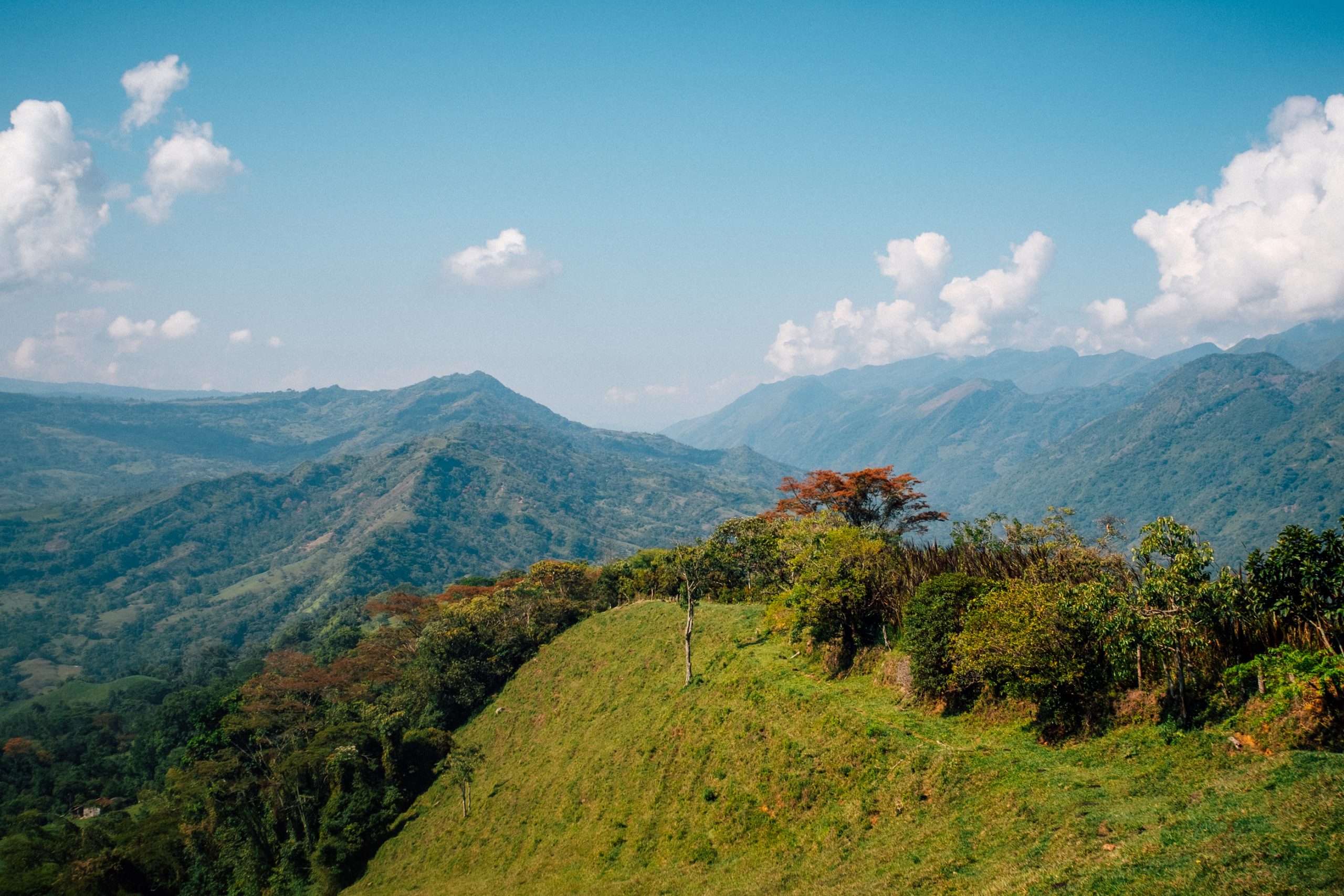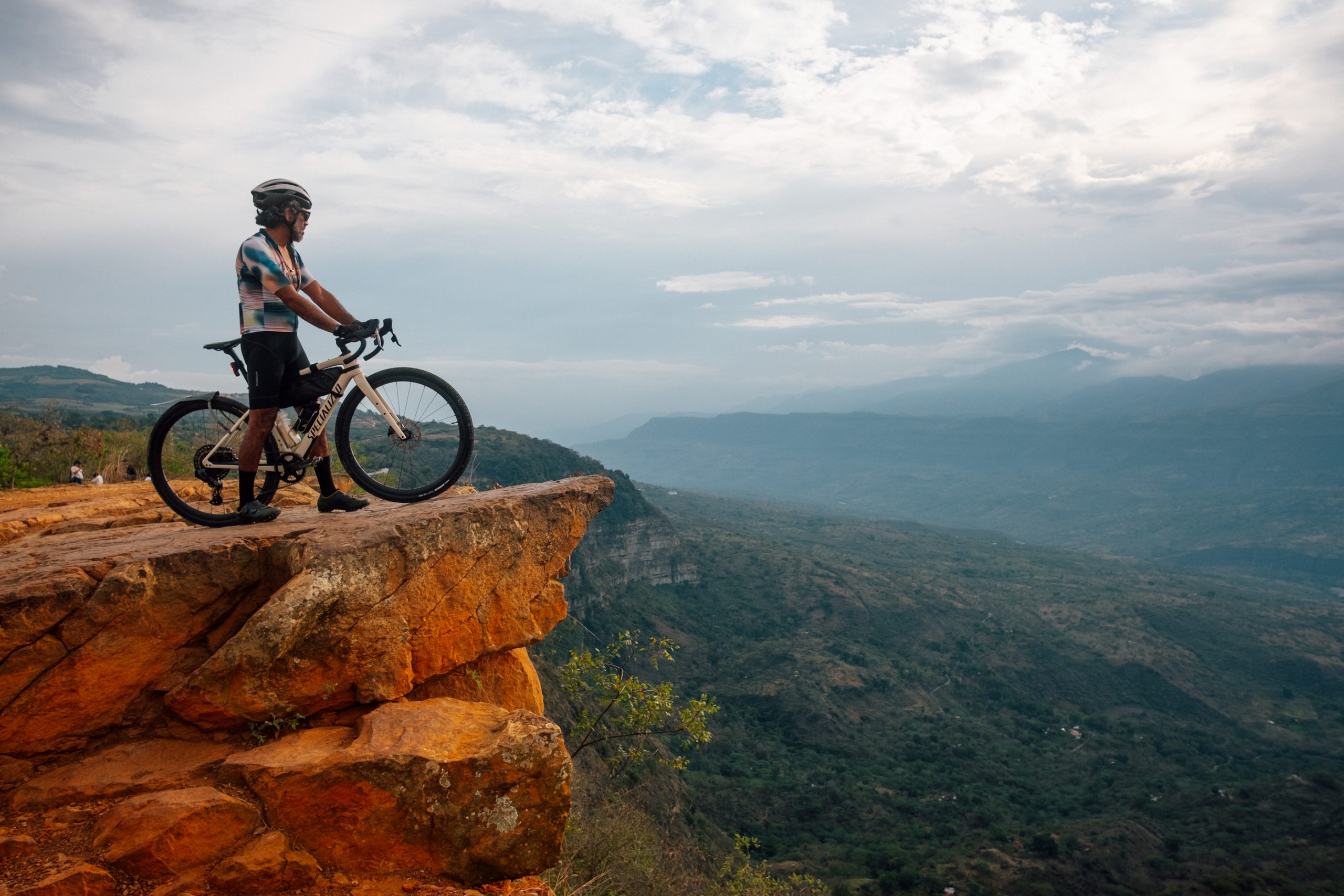In March, Jonas Jungblut checked firsthand whether there is any gravel in Colombia, or if it is too rough to be considered suitable. Together with six other cyclists, three from the US, including him, and three locals, he tackled the Colombian Andes for five days. In this story, Jonas narrates the challenges of riding self-supported far from home, the dynamics of the group, and the emotions when overcoming physical and mental hurdles.
It’s 9 pm and we drag the bike cartons that house our bikes across the floor of the Bucaramanga airport. To our delight, they look intact, given that they just endured four separate flights, from California to Texas, to Panama City, and now Colombia. This seems to be a good start. They are cardboard after all.
Our first hurdle arrives minutes later and serves as a mindset adjustment to traveling in South America. Our ride is a small egg of a vehicle, and after about 30 minutes of debate, ditching the cartons and somehow stuffing the disassembled bikes and ourselves into given vehicle, we set off, only to immediately be shut down again by one of the front wheels breaking off. Go with the flow, enter zen mode.
We are about to embark on an epic, self-supported, gravel bikepacking trip from Barrichara to, almost, Bogota. Colombia has a rich cycling history, is considered largely safe now, and offers insanely beautiful routes. We will be crossing the Andean region, known for its Cordilleras, the Andean ridges. Our route leads us away from main roads and is littered with rampas, a term I will learn to adore and simultaneously fear over the following week.
It is very hot in Barichara, upper 90s and above. While we are waiting for three Colombians to join us, we keep getting text messages about the intended first day’s route from them. 86 miles. 13,000 feet of climbing. I hear these numbers, and a sense of worry is creeping in. It builds on general concerns that come with being in a foreign country, not speaking the language, and embarking on a backcountry trip where an ambulance will most likely have hooves.
But 10 am rolls by, and the Colombians are still nowhere to be seen. Zen mode is fully engaged, and I am starting to realize that we will never do anything close to that brutal of a day. When we finally get going, after multiple stops around the town square for coffee, croissants, water, and the bike shop, two of the Colombians take off in a different direction, and within 5 minutes in the saddle, we are back to standing on the side of the road waiting for them to turn around and join us. The gringos quickly establish some rules.
Rule #1: Follow Mario. Colombian but based with us gringos in California, and organizer of the trip. He knows what’s up and needs to be followed closely.
Rule #4: Wait in the shade.
I can’t recollect rules #2 & #3, they may have never existed. Going from #1 to #4 is in line with the general logistics, though. Zen mode.
After dropping into the valley and meeting the Suarez River, we spend some time on a well-maintained gravel road in 116-degree heat. I am carrying just under two and a half litres of water and a filter just in case. It’s the first day of riding, and I have no idea how frequently there’ll be a chance to refill on fluids. It’s ridiculously hot, and the last thing I want is to overheat on day one. So I drink more than I feel I should, but less than I want. Mario has told me about little side-of-the-road stands and shops being everywhere down here, and this turns out to be right.
Then the road is gone. It just ends in a sheer cliff dropping 30-40 feet into the Suarez River. To the right, the river below, and to the left, a fence and heavy vegetation. Zen mode. Trust the Colombians. Within minutes, someone is through the fence, finds a little trail, and 10 minutes later, we are on the other side of the washout, having ourselves a laugh.
This sort of approach dominates the next couple of days. The Colombians actually have a riding club called “Sin Ruta”, without a route, which progressively makes more sense to me. Every time we stop at a fork in the road, they argue about the route. Rule #4. One guy takes off in a direction that nobody else believes to be correct, Rule #1. And so we move along, someone yells “Rampa!”, and the train stretches out. We meet at the top and take some photos, and then continue back down through the jungle.
Despite these constant arguments over the route, we end up at our destination for the day almost every day, and I am pleasantly surprised by how nice the little hotels are that we are spending our nights at.
While this trip is self-supported, we don’t have to carry large amounts of food or sleeping gear. We load up on “bocadillos”, a very sweet, gel-like guava paste wrapped in bijao leaves. We complement them with wafers and cookies, and whatever we can find that is efficient to carry.
The bocadillos are great since they are full of fuel, and we can just chuck the wrapper since it’s a leaf. In the town of Chima, we go so bonkers with the bocadillos that in the little hole-in-the-wall store that surprisingly has everything one could ever want or need in it, they laugh, shake their heads. Word gets out to the street, and now people come in and check out the crazies buying 30 bocadillos. We collectively get over the bocadillos after consuming all those.
Carrying excessive amounts of Guava paste and loading the bike down turns out to be unnecessary anyway. We are not pushing that hard, and there is always some place to eat and have another café along the way. And for sleeping, the hotels are basic but very nice. Clean, charming, and they wash our gear for us. There is always a hose to spray down the bikes and, for the most part, warm water to shower off.
In the town of Contratacion, we have an amazing lunch. Afterwards, Mario and I are waiting in the shade of a building for the others to find coffee, and Mario tells me that this town was the scene of a major battle in the war against the rebels. To the point where the town was almost completely destroyed, and all the inhabitants had to flee. It hadn’t been on my mind, but I realize that 10-15 years earlier, this trip would not have been possible. Months later, on a ride back in California, Mario would confide that he wasn’t “not” concerned about getting abducted by rebels. I was glad he kept that worry to himself…
After a short climb out of Contratación we descend what turns out to be the longest descent on dirt of the trip. It’s rough. Steep, loose, and littered with stones ranging in size from golf balls to fist-sized and larger. It’s also not one to get hurt on, given that we are far away from proper medical help. My hands are cramping, my legs are hurting, it’s not fun, and I like descending. It is entertaining how everyone is complaining about it, and how happy we all are as we get to the bottom and stop at a bridge.
Within a few minutes, two cowboys on horses appear and have a conversation with the Colombians. I don’t understand anything, but there is weird tension, and it sounds heated. Eventually, they ride off, and I am told that the main guy was complaining about people reporting him for animal cruelty or something in that direction. Oddly, people taking pictures was his worry, yet he lets me take a portrait of him on his horse anyway.
On the morning of Day 3, Zen mode has officially taken a break, and it’s decided to cut the elaborate breakfast and subsequent second coffee, paired with general lingering out of the program. A more rigid program is introduced, which has us, theoretically, get on the bikes at 8 am sharp so that we can spend some more time in the saddle versus drinking coffee and arguing about the route.
The classic challenges a seven-person group creates are surfacing, and democratic measures are put into place in order to keep everyone happy, yet on track. We’ve also gained a new member, the town-square bully on four legs, who accompanies us for over 10 miles. Much to our entertainment and confusion, the talk of the morning is how far the dog will go before he turns around.
There is a stop along a river and then another at Cascada de los Caballeros, a beautiful waterfall with a trail leading up the cliff, going behind the waterfall and topping out at the river that feeds the falls. We climb behind the falling water and swim in the river, and it’s just beautiful.
At the bottom of the waterfall, where we stored our bikes, a woman is hosting us with drinks and conversation. As we leave, I notice that her kitchen is in a separate structure on the other side of the road. It’s a half-enclosed little structure made of bricks and concrete with a metal roof and a wood fireplace in it that acts as a stove. It looks like it’s about to fall over any second. I stare at it, thinking about kitchens at home in the States, and wonder.
Later that day, we meet the mother of all rampas. I watch the number indicating the incline on my bike computer climb into the teens and look ahead to gauge how long I will have to suffer. The road is twisty-turny, and I am sure that it’ll level out after the upcoming bend in the road. It doesn’t. The little number on my computer is now in the 20s, and the route on the Wahoo is deep black; zooming out doesn’t help. I am starting to question how long I can climb this rampa at given incline and under my circumstances. From gearing to bags weighing down the bike to fatigue in my legs from the previous days, I am struggling.
Again, I look up, and it just must level out after this next bend. It doesn’t. What it does do, though, is increase in steepness. My computer at one point reads a questionable 34 degrees of incline. It drags along. Our group is spread far apart at this point. I get to a point where I can’t handle it, and I have to push for a couple hundred feet before the ego kicks in and forces me back in the saddle. In two miles, we climb 1400 feet of elevation.
On the final rampa of the day, we stop at a sugarcane processing facility. It is a small operation, half enclosed. We watch the syrupy goo flow through multiple metal bins until it gets dried in the form of little bricks and packaged in cardboard cartons. Youngsters as well as weathered men standing around, working or looking at their phones and eyeing us curiously. Sunlight is streaming in through the cracks of the tarp covering the area and hits the steam, creating a dramatic and beautiful scene.
As we leave, a teenager on his mountain bike gets on the rear wheel of Mark, who, next to Ricky, is the strongest rider in the group. They take off. When we finally catch up, they are waiting on the side of the road, having a chat. Turns out the kid clung to Mark’s rear wheel for the entire climb and, while clearly overextending himself, didn’t let up. Even pulling some attacks here and there. This is Colombia.
While traversing a long agricultural valley on the way to Ubaté on day four, I realize something. Every day, I am graced by a moment of complete bliss. This feeling when everything is just perfect. Nirvana! Rolling along, body feels great, bike feels great, road feels great, the light is perfect, the landscape is stunning, a complete lack of any negative feelings. Utter bliss. And I recognize that I have had one of these moments every day since we left Barichara. Acknowledging it and taking it in feels even more empowering. It is brought on by the challenge, the adventure, and the successful wrangling of it.
Two days later, I have another realization. I make my way up another rampa, this one not so brutal, and I am overwhelmed with a feeling of being proud of myself. I have never felt like this before.
Committing to this trip came with a lot of fears and mental load. For months, I was going back and forth on whether I even wanted to do it. Once I did, other fears crept in. Was Colombia really safe? Was I fit enough? How would I find a new bike box before my departure? An endless, anxiety-driving list of logistical as well as mental hurdles. Yet there I was, basically at the end of the journey, and I had done it. I had not given in to fears; I had jumped every hurdle I was presented with. It felt good. Trusting in your abilities and reaping the rewards always feels good. Also, Zen mode helped.
Ricky, the youngest in the group, leads Mario, Mark, and me up a rampa that has our heads shaking and pushing the bikes. He is on a mountain bike, which, considering the entirety of the ride, is impressive, but in this case, the right tool. The gravel bikes are no match for this shortcut.
We are also experiencing our first rain, if only a brief and light shower. Rain was a worry leading up to the trip, given our riding on dirt and somewhat of a lack of real rain gear, but it had not been a factor, and this little bit of drizzle is almost welcome.
In the early evening, we arrive in Villa de Leyva and its massive town square. Given the large amount of broken glass between the cobbles, this turns out to be a questionable move, but luckily, no flats. Villa De Leyva was one of the inspirations for Mario to organize this trip. He had spent time here in his youth and is reminiscing about some good times. We clean up in a beautiful hotel and head to dinner near the square.
I had gone through a fair number of options for shoes to wear off the bike during the trip. Size and weight were important factors, knowing that I had to carry the shoes on the bike. At the same time, I didn’t want to fly internationally in Havaianas. In the end, I settled for my son’s worn-out Crocs. They were the lightest option outside flip-flops, could get wet, and were easy to strap to my seatpost bag. While not fashionable, they are very comfortable, but hey, nothing else on me was fashionable. Walking to dinner in Villa De Leyva, I do feel slightly self-conscious in those Crocs, though.
Leaving Villa De Leyva the day after, we have to ride on a proper road for a little over 20 miles, and while manageable for the most part, there is a stretch of 3-4 miles, climbing out of the valley, where there is no shoulder and traffic is heavy. I am by myself and bathed in diesel fumes. Trucks are flying by within a few feet of me. This is likely the most uncomfortable I’ve been on a bike in a long time. Pulling off that road, out of traffic, and onto dirt feels like a release from pain.
We keep getting chased by dogs darting out of driveways as we ride by, especially Mark for some reason, and the Colombians keep arguing about the route. Before too long, we are at 10,000 feet of elevation.
I am surrounded by lush green meadows and ferns, and tall trees. It’s almost jungle-esque. In the Austrian Alps, the mountain range I spent my childhood and youth in, this would be shale rock. Not a living thing in sight. It’s perplexing and welcome at the same time.
This is my last full day of riding. I have an earlier flight than the others. Our destination that day is Fuga, an amazing glamping spot in Neusa, just a bit north of Bogota. After that horrible stretch on the road, with traffic and fumes, two of the Colombians decide to have a coffee in Tausa, the town before the final stretch to Neusa. The rest of us look at the darkening sky and the time of day, and we boogie out of there. This turns out to be a wise choice.
On the final stretch of the dirt road along the lake in Neusa, it gets dark and wild and windy. Kind of scary weather, waiting to unleash a thunderstorm on us. We are moving fast despite having over 60 miles and 6500 feet of climbing in our legs. I don’t want to be caught by this storm on a dirt road in these conditions.
Within five minutes of arriving at Fuga, the skies let loose, and it’s pouring like there is no tomorrow. Heavy, thick rain. Combined with darkness, lightning, and being at over 10,000 feet of elevation, I feel for those two poor bastards out there in the mud trying to make it to safety. One of those times when not going zen mode was a good choice.
We have a fantastic meal in the modern dining room at Fuga once reunited, and it is a perfect location for me to end the trip.
I wake up the next morning right next to a window that spans the full length of my bed and offers a view of the lake and the ranges in the distance. It’s beautiful. From Fuga I ride by myself down to Zipaquirá where a bike box is waiting for me. I spend the afternoon packing up the bike and taking it easy. Early the next morning, I sit at a cafe by the town square, sipping a cappuccino and having myself a chocolate croissant as a group of cyclists rides by. I am wearing my sweat-drenched cap and we exchange a quick nod.
Jonas’ story becomes the first guest contribution in our online magazine, and your future bike adventure could be the next one. Simply get in touch and join the community.



